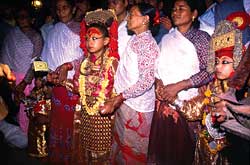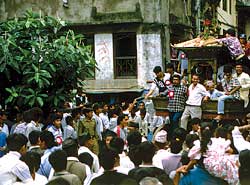 These days, Nepalis need all the blessings they can get. Maoist rebels have been waging war against the monarchy for eight years, displacing hundreds of thousands of people. Amid so much political strife, traditions like the royal kumari provide comfort and continuity. But some Nepalis have begun questioning the tradition, arguing that this once-prestigious position is a violation of human rights
These days, Nepalis need all the blessings they can get. Maoist rebels have been waging war against the monarchy for eight years, displacing hundreds of thousands of people. Amid so much political strife, traditions like the royal kumari provide comfort and continuity. But some Nepalis have begun questioning the tradition, arguing that this once-prestigious position is a violation of human rights A generation ago, hundreds of parents would offer their daughters for the royal kumari selection process, considering the post an honour. But in 2001, when royal caretakers went from house to house in Kathmandu looking for a prospective goddess, only five parents were willing to offer their daughters.
When the caretakers came to Preeti Shakya's door, her mother was ambivalent about letting the three-year-old be evaluated. "I didn't want to give her horoscope for consideration," says Reena Shakya, sitting in her living room today. "But how could I say no?"
Preeti's horoscope proved harmonious with the king's. The next step was to examine the girl for 'the 32 perfections', a divine tick list that seems more suited to a character in a Harry Potter novel than to real girl. The royal kumari must have 'a body shaped like a banyan tree, thighs like a deer's, cheeks like a lion's, a neck like a conch shell and a voice clear and soft as duck's'. The royal priest's wife confirmed that Preeti possessed these attributes and also had clear skin, black hair and eyes and a moist tongue.
The three-year-old was then taken to live with her new family at the kumari ghar. "You can imagine what a mother might feel," Reena laments. "My baby was going to be taken away from me for years. As soon as they took her, I knew she had already become a goddess."
For the past three years, Reena Shakya has seen Preeti only once a week, when she visits her at the ghar. "I go as an ordinary worshipper," Reena says. "I have to think of her as a goddess before I think of her as a daughter." Preeti's older sister, however, is allowed to play with the pint-size deity on Saturdays. From her daughters' interactions, Reena has learned that Preeti is now a cheerful, active six-year-old who loves to play dress-up and eat ice cream-when she is not receiving devotees.
 As the royal kumari, Preeti follows a strict routine. Early every morning, attendants dress her in a red and gold brocade gown, pull her hair into a ritual bun and paint a vermilion, black and gold all-seeing third eye on her forehead. At around 9AM, Preeti settles into her throne so priests can come and make offerings to appease the Taleju goddess. After that, Preeti spends several hours receiving and blessing a dozen or so devotees before beginning her daily studies. Then, finally, she is free to play. Even in her rare moments of childhood fun, Preeti is restricted. She can walk only on special cloths set down on the floor and she is forbidden to go out in the sunlight, except during a dozen public appearances a year.
As the royal kumari, Preeti follows a strict routine. Early every morning, attendants dress her in a red and gold brocade gown, pull her hair into a ritual bun and paint a vermilion, black and gold all-seeing third eye on her forehead. At around 9AM, Preeti settles into her throne so priests can come and make offerings to appease the Taleju goddess. After that, Preeti spends several hours receiving and blessing a dozen or so devotees before beginning her daily studies. Then, finally, she is free to play. Even in her rare moments of childhood fun, Preeti is restricted. She can walk only on special cloths set down on the floor and she is forbidden to go out in the sunlight, except during a dozen public appearances a year. Just before she hits puberty, Preeti will be thrust back into the real world. She will return to a family she barely knows and be expected to perform household chores, like any other adolescent girl. But unlike other Nepali teens, Preeti will have never walked down a city street, chosen her own outfit, or helped her mother cook a meal before.
This abrupt shift from goddess to mortal is rocky for both the girls and their families. "It was very hard. All I wanted to do was go back to the kumari house," says former kumari Rashmila Shakya, 23. The only visible remnant linking Rashmila to her days as a goddess, besides the photos of her that adorn her family's sitting room, is a bald spot on her head from having her hair pulled into a tight bun every day for nearly nine years. "It was home and family to me," Rashmila says. "I didn't know how to face my freedom. I had to struggle to get back into the educational system after I came home."
 Rashmila, like all royal kumaris before her, received no education during her reign. She began second grade at age 12. After years of hard work playing catch-up in school, she recently began studying for a bachelor's degree in information technology and she dreams of designing software. When she graduates, Rashmila will be the first former goddess with a college degree.
Rashmila, like all royal kumaris before her, received no education during her reign. She began second grade at age 12. After years of hard work playing catch-up in school, she recently began studying for a bachelor's degree in information technology and she dreams of designing software. When she graduates, Rashmila will be the first former goddess with a college degree. But despite her difficult adjustment, Rashmila has no regrets about her past. "It was an honour," she says. "Not everyone is chosen to be the kumari. It is something I am very proud of."
Rashmila's successor, Amita Shakya, did receive tutoring, thanks to her parents, who pushed for reform. Amita, now 14, agreed to be interviewed only with her parents present. She is slumped on a stool in the family's living room, dressed like an ordinary Nepali teenager in faded jeans and a pink T-shirt. She is silent as her father describes his struggle to secure a tutor for Amita during her reign as kumari. "I sent letters to the palace many times," he recalls. "But their attitude was, 'Your daughter is a goddess. Why does she need an education?'"
It wasn't until Mimita Shakya, Amita's mother, personally handed a letter to King Birendra at a kumari ceremony that changes were made. Five years after Amita had been appointed a royal kumari, the king arranged formal education for the child goddess.
Today, Preeti has a private tutor sent to her quarters each day. Although she is not allowed to attend classes and socialise with other children, she follows the government-prescribed 10-month curriculum for all Nepali schoolchildren.
 In September 2002, MP Bidya Bhandari, took a public stand against the kumari tradition during a press conference. She urged that the tradition be abolished: "This is a violation not only of the rights of the child, but of women's and human rights," she said. "The girl is isolated from normal society and after a number of years, when she begins to bleed, she is thrown out. It is not only traumatising, it is psychologically damaging for a child to be forced to shift between these two worlds."
In September 2002, MP Bidya Bhandari, took a public stand against the kumari tradition during a press conference. She urged that the tradition be abolished: "This is a violation not only of the rights of the child, but of women's and human rights," she said. "The girl is isolated from normal society and after a number of years, when she begins to bleed, she is thrown out. It is not only traumatising, it is psychologically damaging for a child to be forced to shift between these two worlds." Sapana Pradhan Malla, a lawyer and human-rights activist who founded the Forum for Women, Law and Development, agrees: "You are chosen when you are not able to decide what is good or bad for you. The child's interests are decided by parents who see this as a prestige issue, because the kumari is respected by the king."
It's no simple matter to abolish a tradition based on centuries of religious faith. "There are some things that are beyond normal human understanding," says Ramesh Prasad Pandey, a 72-year-old priest who has overseen the selection of three royal kumaris. "I could place a stone on the table, and if I see the sacred in it, then it becomes imbued with the sacred. But you could see it merely as a rock. It is the same principle with the kumari. It's a question of belief."
Sapana Pradhan Malla acknowledges that the kumari tradition is probably too much a part of Nepali culture to abolish. So instead, she proposes further reform. "The girl's rights should be protected," she says. "She should be given adequate opportunity for development and education, and she should get counseling before she gives up her position. It is the state's responsibility to protect her rights."
While the government does provide a modest lifelong pension of Rs 3,000 rupees a month for its former goddesses this is a pittance compared to the value of a lost childhood.
One day, Preeti Shakya will voice her own opinion. But for now, the goddess remains apart from mere mortals, until she begins to mature and suffers her inevitable fall from grace.
This year\'s Indra Jatra is on Monday, 27th September.


